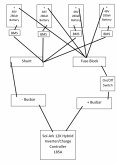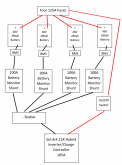Gnubie answered questions spot on.
A good reference doc you should look over, starting at Page 17.
VICTRON Wiring-Unlimited-EN.pdf
Standard Good Practice simplified.
48 Volt 16S Pack with 16S BMS to manage each cell and it's entire pack as an independant entity.
All Packs set in Parallel with equal length identical wiring to BusBar Block (the most efficient connection method)
Each pack with it's own Fuse. (MRBF Fuses work a treat for this)
! Each pack must be capable of handling the FULL Charge/Discharge rates the equipment can take/push. With multiple packs in a bank, each pack
must be able to handle the "full deal" in the event the other packs cutoff for any reason, otherwise failures will occur.
Properly Paralleled packs can share Load & Charge equally and if all packs are matched up properly, they shoudl all work in tandem, yet if one or more packs get out of sync they can continue to function untill fully recharged collectively.
Caveats:
- Ensuring that the BMS' on each pack are set with identical cutoff points for Hi/Low Volt cutoff & Temp Cutoffs. If not set properly, teh packs will not interact as well as they should.
-
The entire system needs to be Voltage Calibrated. This is to ensure that when the SCC reads 50.0V at "it's terminals" that the voltage at the Busbar is exactly the same and the same applied to the Inverter/Charger as well. THESE CANNOT BE OFF ! THIS IS CRITICAL with Lithium Battery Systems where 0.5V can make a real difference. See link in my signature related to Calibrating.
- Multiple BMS' will act independently BUT this creates a Problem too with "some" equipment. With some gear, they have the ability to communicate with a BMS and interact with it, to do such things as shutdown or idle an Inverter or even interact with the SCC to control charging. MOST BMS' cannot work in a "pool" of BMS's that can interact with a "single" device. This would reqquire an "Intermediary or Monkey in the Middle" between the battery packs in the bank and the devices. The BMS Tech exists for this, it's called Distributed BMS' but you had better be sitting down and have a Tylenol bottle on hand before looking at the costs. Maybe even a quadruple shot of Jack Daniel's.
- BMS' in General: There are several types of BMS', some will do series, some will do parallel and some do both. There are Relay/Contactor models which handle higher amperages and there are mosFET based ones without Relays/Contactors (typically cap around 200A Discharge / 100A charge). The BMS choice depends on the Inverter Draw Capacity & the Solar Charge Capacity. If the invverter will pull 5000W / 105A from the batteries & the SCC can push 100A Charge, you will want to ensure teh BMS' on ALL packs can take 100A Charge and comfortably discharge 105A (just random numbers) with FET based BMS' you woudl want at least 25% overhead space so as to not tax the BMS and push it to the edge of it's specs. The CATCH or GOTCHA, typically FET Based BMS' allow for 50% charge rate compared to their discharge rate. So a 200A Fet BMS would allow for 200A Discharge & 100A charge rate. This is quite normal.
280AH cell Note. They are Commmodity Grade-A Cells, which means they qualify as Grade-A and fit teh Factory specs and tested to comply with that spec, (it's a general spec) but these cells are NOT factory Matched & Batched, they are only basically simple Voltage & IR matched at "one voltage - the storage voltage".
These cells can discharge at 1C rate or 280A max.
These cells can charge up to 1C rate BUT the recomendation is to not exceed 0.5C rate or 140A for maximized life, performance & thermal control. The higher the rate the more heat the cells will generate due to the chemicial interaction. These commodity cells can easily see 1mv per Amp Hour differential between the cells and this will be more pronounced at the low & hi SOC states. Passive Balancing on these cells is almost pointless UNLESS they have been perfectly Matched & Top & Bottom Balanced. (propely Matched & Batched cells cost much more it is a long process of testing, evaluation and batching)
Some Refrence info for you. Orion BMS company has excellent docs, and it is an excellent BMS company, so...
BU-803a: Cell Matching and Balancing – Battery University
Pre-Balancing Cells | Orion Li-Ion Battery Management System
High resistance cell | Orion Li-Ion Battery Management System




